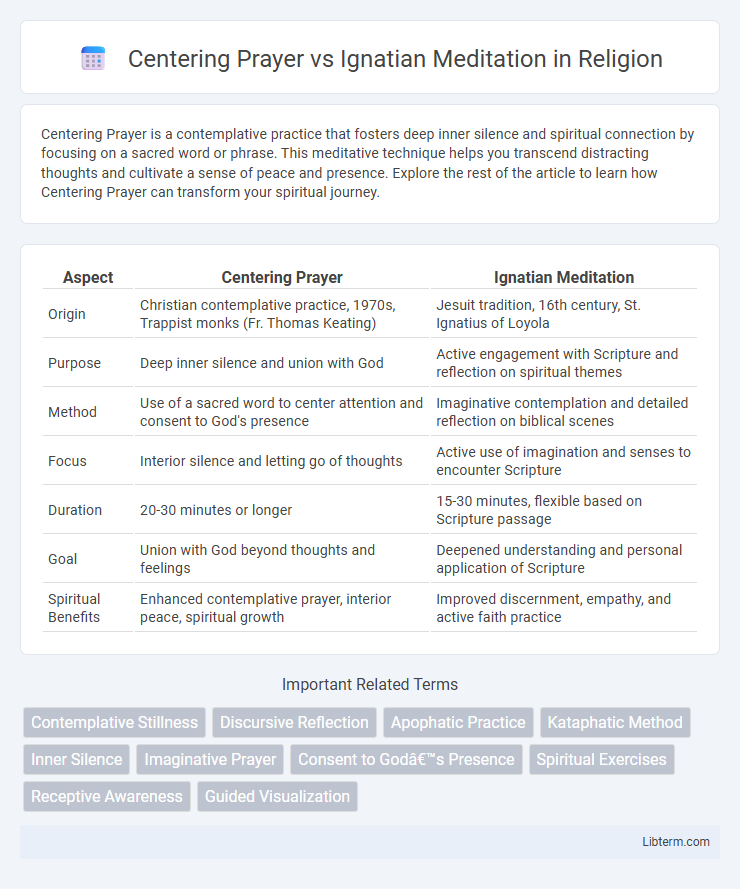Centering Prayer is a contemplative practice that fosters deep inner silence and spiritual connection by focusing on a sacred word or phrase. This meditative technique helps you transcend distracting thoughts and cultivate a sense of peace and presence. Explore the rest of the article to learn how Centering Prayer can transform your spiritual journey.
Table of Comparison
| Aspect | Centering Prayer | Ignatian Meditation |
|---|---|---|
| Origin | Christian contemplative practice, 1970s, Trappist monks (Fr. Thomas Keating) | Jesuit tradition, 16th century, St. Ignatius of Loyola |
| Purpose | Deep inner silence and union with God | Active engagement with Scripture and reflection on spiritual themes |
| Method | Use of a sacred word to center attention and consent to God's presence | Imaginative contemplation and detailed reflection on biblical scenes |
| Focus | Interior silence and letting go of thoughts | Active use of imagination and senses to encounter Scripture |
| Duration | 20-30 minutes or longer | 15-30 minutes, flexible based on Scripture passage |
| Goal | Union with God beyond thoughts and feelings | Deepened understanding and personal application of Scripture |
| Spiritual Benefits | Enhanced contemplative prayer, interior peace, spiritual growth | Improved discernment, empathy, and active faith practice |
Understanding Centering Prayer
Centering Prayer centers on silent, contemplative practice aimed at deepening communion with God by letting go of thoughts and intentions. It emphasizes interior silence and receptivity, inviting practitioners to surrender to divine presence beyond mental activity. Unlike Ignatian Meditation, which involves active imagination and reflection on Scripture, Centering Prayer fosters pure awareness and surrender without engaging the intellect.
Key Principles of Ignatian Meditation
Ignatian Meditation centers on engaging the imagination and senses to vividly place oneself within a biblical scene, fostering deep personal connection with scripture. It emphasizes active reflection, inviting the practitioner to discern God's presence and guidance through attentive listening and contemplation. This method contrasts with Centering Prayer's focus on interior silence and receptive waiting, highlighting Ignatian Meditation's dynamic, imaginative approach to spiritual growth.
Historical Origins of Both Practices
Centering Prayer originated in the 1970s through the work of Trappist monks Thomas Keating, William Meninger, and Basil Pennington, drawing on ancient Christian contemplative traditions like the Cloud of Unknowing. Ignatian Meditation has its roots in the 16th century, developed by St. Ignatius of Loyola as part of his Spiritual Exercises, emphasizing imaginative engagement with Scripture to deepen faith. Both practices reflect distinct historical contexts--Centering Prayer emerging from modern monastic renewal and Ignatian Meditation from Renaissance-era spiritual discipline.
Core Techniques: A Comparative Overview
Centering Prayer centers on silent, wordless meditation using a sacred word to return focus to God, emphasizing interior stillness and letting go of thoughts. Ignatian Meditation involves active imagination and contemplation, engaging the senses to deepen scripture understanding and foster personal connection with biblical scenes. Both practices aim for spiritual growth but differ: Centering Prayer is primarily passive and interior, while Ignatian Meditation is active and imagistic.
The Role of Silence in Centering Prayer
Centering Prayer emphasizes the role of silence as a means to quiet the mind and open the heart to divine presence beyond words and thoughts. This contemplative practice fosters interior silence, allowing practitioners to experience a deeper union with God by letting go of mental distractions and habitual thoughts. Unlike Ignatian Meditation, which involves active engagement with scripture through imaginative reflection and dialogue, Centering Prayer prioritizes receptive silence as the path to spiritual transformation.
Guided Reflection in Ignatian Meditation
Ignatian Meditation centers on guided reflection that prompts practitioners to engage deeply with Scripture by imagining scenes and discerning personal meaning, enhancing spiritual insight. This active contemplation differs from Centering Prayer's approach, which emphasizes silent prayer and relinquishing thoughts to experience divine presence without structured prompts. Guided reflection in Ignatian Meditation cultivates a dynamic dialogue between the individual and the biblical text, fostering moral discernment and personal transformation.
Spiritual Goals: Contemplation vs. Discernment
Centering Prayer emphasizes silent contemplation aimed at deepening union with God through inner stillness and surrender, fostering a direct experience of divine presence beyond words or images. Ignatian Meditation prioritizes active discernment by engaging imagination and reflection on Scripture to recognize God's guidance in daily decisions and moral choices. Both practices cultivate spiritual growth but differ as Centering Prayer seeks transformative communion, while Ignatian Meditation focuses on practical discernment for living faith intentionally.
Psychological and Emotional Benefits
Centering Prayer fosters deep inner silence and mindfulness, reducing stress and enhancing emotional regulation by encouraging non-judgmental awareness of thoughts. Ignatian Meditation engages imagination and reflection on Biblical scenes, promoting emotional insight, self-awareness, and moral clarity through active contemplation. Both practices support psychological well-being by cultivating presence and resilience, but Centering Prayer emphasizes a calming, receptive state while Ignatian Meditation involves dynamic visualization and discernment.
Integrating Practices into Daily Life
Centering Prayer emphasizes silent receptivity and letting go of thoughts, fostering inner stillness that can be seamlessly incorporated into daily routines through brief, dedicated prayer periods. Ignatian Meditation involves active imagination and reflective contemplation on scripture, encouraging individuals to engage senses and emotions, which can be integrated by journaling or mindful pauses during everyday activities. Both practices offer complementary pathways for deepening spiritual life, adaptable to busy modern schedules by cultivating mindfulness in ordinary moments.
Choosing the Right Practice for Personal Growth
Centering Prayer emphasizes silent, wordless communion with God to deepen spiritual intimacy and foster inner stillness, while Ignatian Meditation involves active engagement with Scripture through imaginative contemplation to discern personal calling and moral decisions. Selecting the right practice depends on whether one seeks contemplative silence to cultivate presence or dynamic reflection to stimulate spiritual insight and actionable guidance. Evaluating personal spiritual goals and temperament helps determine which method best supports sustained personal growth and spiritual transformation.
Centering Prayer Infographic

 libterm.com
libterm.com